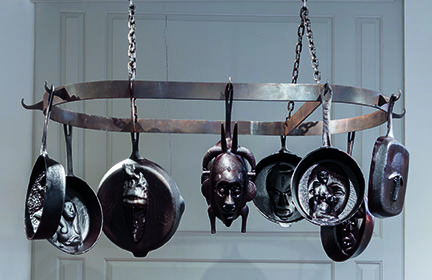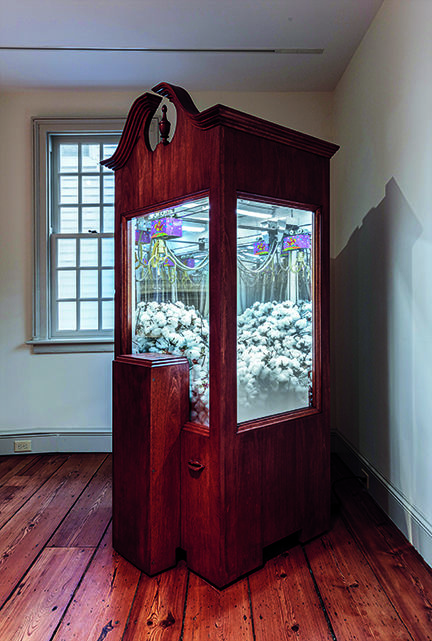Exhibition: Hugh Hayden / Creation Myths
In Creation Myths, the second installation at Art@Bainbridge, the Museum’s space for contemporary art in the historic Bainbridge House on Nassau Street, the artist Hugh Hayden explores themes such as identity, class, and history and how they intersect with domestic objects and spaces. Hayden’s works suggest topics as diverse as the cultural idea of the American Dream, the twentieth century’s Great Migration, and the layered histories carried by cultural artifacts. For this site-responsive project, the artist has used the layout of the house’s main level to suggest four distinct spaces: kitchen, dining room, study, and schoolroom.
Hayden populates the rooms with existing sculptures as well as with new works tailored to this setting, focusing specifically on the connections between Art@Bainbridge and the Art Museum. For the kitchen, the first room one enters, Hayden considered the context of both Bainbridge House and works in the Museum’s collections to create eight cast-iron skillets that incorporate the forms of African masks and other artworks that relate to African and African diaspora peoples. Hayden visited the Museum and selected a group of works that were then digitally scanned. These images were combined with scans of cast-iron skillets and assembled by the artist into digital renderings of the final works. The renderings were 3-D printed in sand using a new technology designed for producing precision machine parts; the printed objects were then cast by a foundry in Indiana using a traditional iron-casting technique and installed hanging at eye level in the kitchen, allowing the viewer to see both sides of each skillet.
The resulting works bear traces of how they were made. Scanning picks up some elements of the objects but not others, resulting in a loss of detail in places; in addition, the 3-D printer builds up the sand cast in sequential layers that are visible in the striated surfaces of the pans. The highly “worked” surfaces and clearly altered appearances of the final objects register the technologies used by the artist. For most of the skillets, Hayden has paired works created by African artists with works related to African peoples but executed by Western makers. For example, in 2-Way Mirror, Hayden has juxtaposed a scan of Paul Gauguin’s sculpture Woman of Martinique (1889), on long-term loan to the Museum from the Henry and Rose Pearlman Foundation, with a Fang mask from central Africa. This pairing thus contrasts a white, European artist’s representation of a woman—likely descended from African slaves and living in a French colony—with a mask that shows a male Fang artist’s representation of a white woman.
Like much of Hayden’s work, the skillets are emblematic of the artist’s concern with cultural transmission as it occurs across time and space. A quintessential tool of African American cuisine, the cast-iron skillet acts as a ground in each pairing, the device in which these cultural hybrids are “cooked.” Introducing us to Creation Myths, this installation shapes our interpretation of the rest of the exhibition and helps us to see the multivalent meanings present in the other artworks on view. For example, the mechanization of cotton picking, represented in Hayden’s recently completed High Cotton, an adapted claw grabber game, acts as a commentary on the history of slavery and on the so-called Great Migration beginning in the 1920s, when many black Americans left an agricultural way of life in the South for the promise of industrial jobs in the North.
The table and chair set, America, evokes the myth of the American Dream through the invocation of home and the democratic ideal represented by the circular table. However, through the seemingly repellant, spiky protrusions carved into each piece, America leaves it open to the viewer to ponder what kinds of identities—be they class, gender, racial, or sexual—are excluded from that dream. Such questions around belonging and identity—so eloquently suggested in America by the oscillation between attraction, found in the rich, beautifully carved wood and the familiar domestic forms, and repulsion, introduced by the menacing spikes—are characteristic of all the works in this thought-provoking exhibition.
Alex Bacon
Curatorial Associate
Art@Bainbridge is made possible through the generous support of the Kathleen C. Sherrerd Program Fund in American Art; Stacey Roth Goergen, Class of 1990, and Robert B. Goergen; and Jonathan Golden, Class of 1959, and Roberta Pritzker Golden. We are also grateful to Lisson Gallery, London, New York, and Shanghai, and CLEARING, New York and Brussels, for their support of this exhibition.



